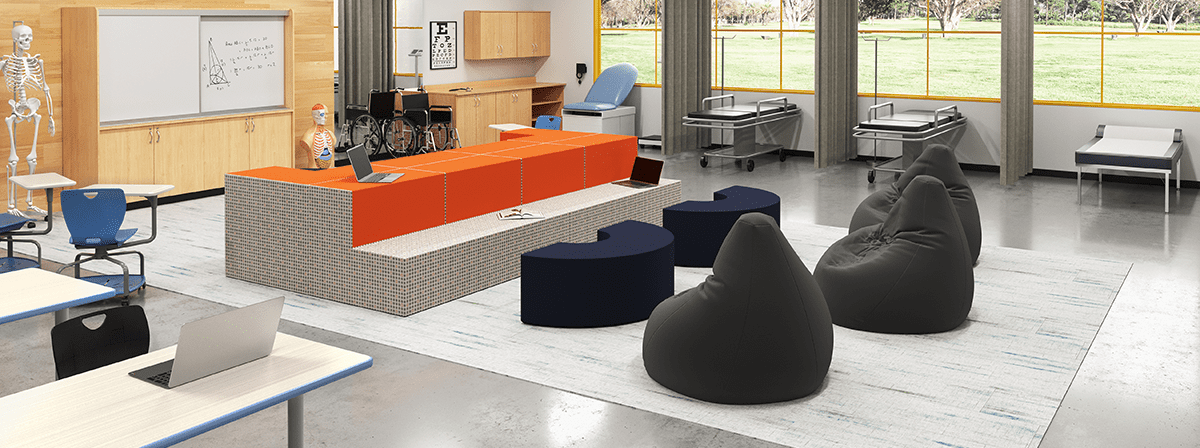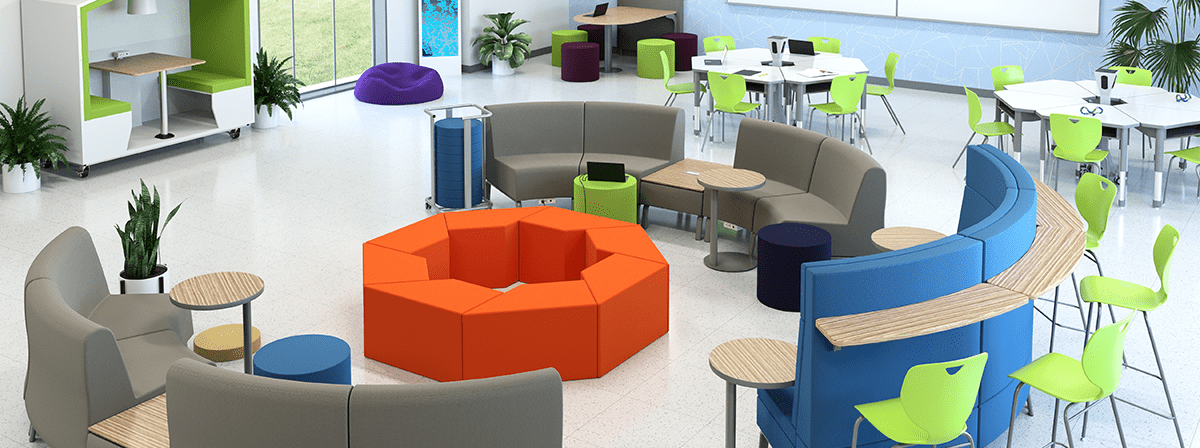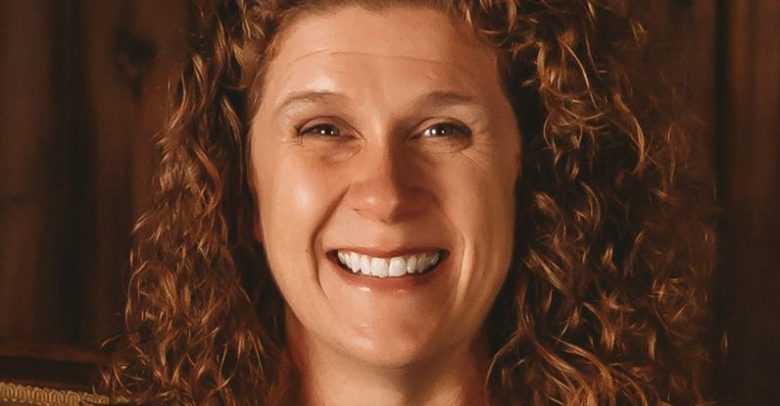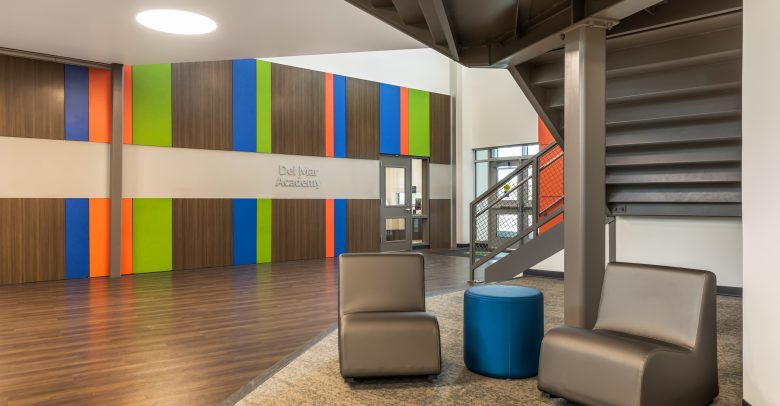There is no denying that students are struggling with mental, social, and emotional well-being. This has affected their ability to focus and learn in school—and it can have long-term implications for their health and safety as well.

One study estimates that anxiety and depression rates among children worldwide have increased greatly, with at least one in five children now suffering from these disorders.
In response to these realities, many K-12 leaders have established programs and supports to improve student well-being, such as weaving social emotional learning (SEL) principles into instruction, adding school counselors and psychologists, teaching educators how to recognize the warning signs of mental health disorders, and connecting students who are at risk with the additional help they need.
Learning Space Design Also Matters
While these are all important strategies, the design of the learning space itself plays a key role in either helping or hindering student well-being. Educators can promote better well-being by creating flexible learning spaces that give students choices in where to sit, foster connection among students, and integrate comfort and inclusiveness into their design.
This idea is backed by research. For instance, a team of Australian researchers examined eight primary and secondary schools in that country and concluded that flexible learning spaces increased student well-being by enhancing comfort, movement, connectedness, and inclusivity.
“It was widely perceived that the teaching and learning taking place in (these) flexible spaces had a positive impact on the social and emotional well-being of teachers and students,” the researchers wrote (Kariippanon et al., 2018).
The losses that students have experienced in the last few years—loss of normalcy, of social contact, and even of friends and family members—have resulted in trauma every bit as devastating as the emotional effects of violence, abuse, neglect, or natural disaster.
The Substance Abuse and Mental Health Services Administration (SAMHSA) has identified six core principles for implementing trauma-informed practices within schools, child care centers, and other public institutions: (1) safety; (2) trust and transparency; (3) peer support; (4) collaboration and mutuality; (5) empowerment, voice, and choice; and (6) cultural, historical, and gender sensitivity.
Here’s how K-12 leaders can integrate these principles into the design of their learning environments to support student well-being and mitigate the effects of trauma.
Safety
Students who are dealing with trauma need to feel safe both physically and psychologically within the learning environment. This means the space itself must be safe and secure, and the interpersonal interactions that take place there must also feel safe for students.
K-12 leaders can foster a sense of security by designing safe school environments that convey confidence, yet also inspire learning, paying attention to elements such as controlling who has access to the building and ensuring visibility throughout all learning spaces.
Maintaining the health of students and staff is also essential. To protect against airborne pathogens, K-12 school systems can adopt a layered approach that involves circulating clean air and filtering out particulates at multiple levels within each facility.
Finally, designing learning environments that are warm, welcoming, and inviting places for students to learn—furnished with soft seating options, wobble stools, standing desks, and other choices that allow students to “find their place” where they’re most comfortable within the classroom—can help promote a sense of psychological safety and security, allowing students to relax and focus on instruction.
Trustworthiness and Transparency
Educators need to establish trust among students, and one of the ways this happens is when classroom operations and decisions are conducted with full transparency. For this reason, educators need to establish clear routines with students so there are no surprises.
The design of the learning environment can support this goal. For instance, forming clearly defined learning “zones” within a classroom can help students understand where to go and what to do to accomplish various tasks, such as independent reading or small group work.
Why just shop for furniture when you can design it?
CLICK to try out School Specialty’s design-it-yourself online furniture shopping experience!

Peer Support
Building connections among students is critical for helping them overcome trauma and feel like part of a learning community. Connectedness “is recognized as a significant contributor to students’ social-emotional well-being,” the Australian researchers noted, and a properly designed learning environment can nurture this sense of connection by facilitating student collaboration.
For example, flexible learning environments with movable furniture that can be configured to support various group sizes and activities make it easy for students to work together to complete group tasks and projects.
“Students found that they developed high-quality relationships with their peers because of increased opportunities for group work and collaboration” within flexible learning environments, the researchers wrote, and they quoted one student as saying: “I think I’ve made more friends with the group work. I know we’ve been in the same school for about three years but with the group work, you become a bit closer.”
Collaboration and Mutuality
Student well-being is supported by the development of healthy relationships between students and their peers and between students and their teachers. Again, modern learning spaces designed with maximum flexibility and movement in mind can help nurture strong student-teacher connections.
“School leadership teams and teachers believed that physically open spaces, coupled with the (active learning) pedagogies (these spaces supported), allowed teacher-student interaction to become more frequent,” Kariippanon and her team of researchers wrote. “Fewer items of furniture in classrooms removed both physical and social barriers between teachers and students, which greatly facilitated interaction and was highly valued by participants. Rather than the teacher being tied to their desk, moving around the space encouraged interaction with students.”
Empowerment, Voice, and Choice
Healing from trauma is enhanced when students “are supported in shared decision-making, choice, and goal setting … (and) in cultivating self-advocacy skills,” SAMHSA observes. A simple way to empower students with a voice in their learning is to give them choices in where to sit by offering multiple seating options, including soft seating, stools that rock back and forth, or tall stools around café-style tables.

Choice also applies to the types of tools and materials students use for learning, and schools should offer a variety of ways that students can express their creativity. Designing flexible, collaborative learning spaces by giving students multiple options in where to sit and what tools and materials to work with promotes responsible decision-making and builds student confidence. When students have the freedom to make learning decisions for themselves, they feel more in charge of their own development.
Cultural, Historical, and Gender Sensitivity
Being responsive to individual needs and differences is another important factor in helping students overcome trauma and feel safe. Flexible, modern learning spaces can do this by making the environment more inclusive. For instance, something as simple as having multiple seating styles can accommodate different learning preferences and help students feel more welcome.
The Australian research team noted that flexible learning spaces gave students more autonomy and accommodated those who were different or had special needs more easily. One teacher said, “I’ve got a child in a wheelchair. I feel that it’s such a more inclusive environment for him because everyone is sitting at different (height) levels and there’s no judgment. And he can access everything in the room, because he’s not getting through rows of chairs and tables.”
Overcoming the Effects of Trauma
As K-12 leaders look for ways to enhance student well-being and overcome the effects of trauma in students’ lives, learning space design should play a pivotal role in these efforts. Creating learning environments that promote choice, comfort, connection, movement, and inclusivity can help foster well-being and lead to deeper engagement in learning.
Dr. Sue Ann Highland
Sue Ann Highland, PhD, is the National Education Strategist for School Specialty. She has more than 25 years of experience as an educator, administrator, and consultant with school systems across the United States, with broad expertise in designing and creating highly effective learning environments.
Read more by Dr. Sue Ann Highland–>







Leave a Reply